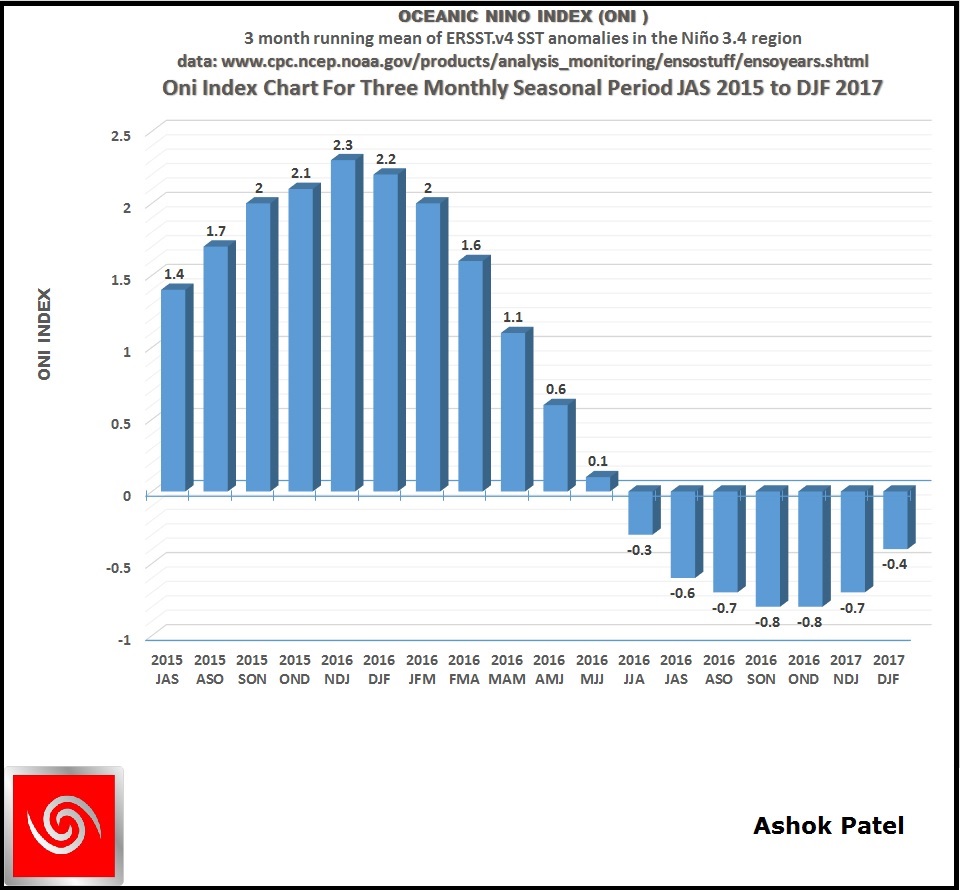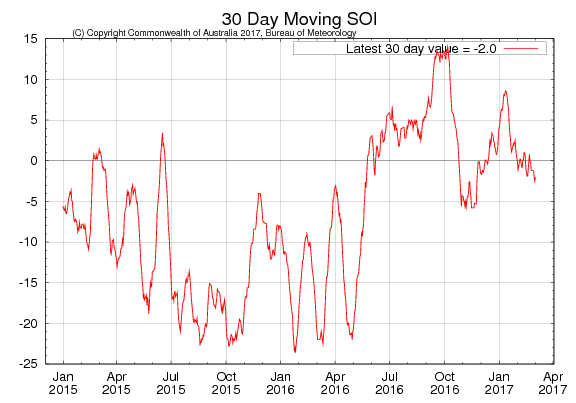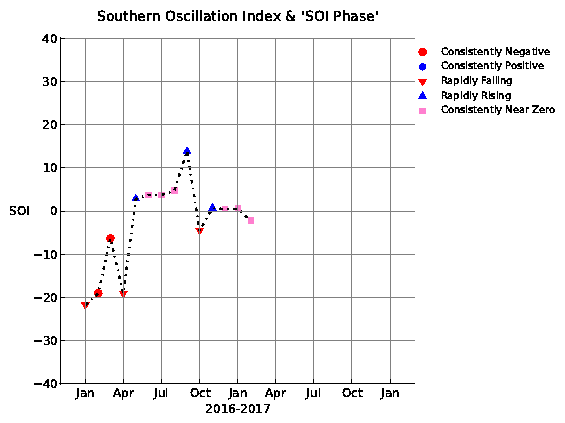ENSO Status on 6th March 2017
The ONI is based on SST departures from average in the Niño 3.4 region, and is a principal measure for monitoring, assessing, and predicting ENSO. Defined as the three-month running-mean SST departures in the Niño 3.4 region. Departures are based on a set of improved homogeneous historical SST analyses (Extended Reconstructed SST – ERSST.v4). The SST reconstruction methodology is described in Huang et al., 2015, J. Climate, vol. 28, 911-930.
CPC uses current Climatology based on 1986-2015 which has been changed late last year from base years 1981-2010. Explanation about Climatology base years change is given here.
NOAA Operational Definitions for El Niño and La Niña, El Niño: characterized by a positive ONI greater than or equal to +0.5ºC. La Niña: characterized by a negative ONI less than or equal to -0.5ºC. By historical standards, to be classified as a full-fledged El Niño or La Niña episode, these thresholds must be exceeded for a period of at least 5 consecutive overlapping 3-month seasons.
CPC considers El Niño or La Niña conditions to occur when the monthly Niño3.4 OISST departures meet or exceed +/- 0.5ºC along with consistent atmospheric features. These anomalies must also be forecast to persist for 3 consecutive months.
Full fledged La Nina event had been confirmed at the end of January 2017 relying on the official NOAA definition for La Nina, because there are now five 3-monthly seasons JAS 2016 at -0.6ºC, ASO 2016 at -0.7ºC, SON 2016 at -0.8ºC, OND 2016 at -0.8ºC, NDJ 2017 at -0.7ºC having La Nina threshold. There is a variation of ONI index by 0.1 C for ASO 2016 where CPC reports -0.8ºC at the source cited.
ONI Index for DJF 2017 is -0.4ºC which is marginally lower than the La Nina thresh hold and hence now the Nino 3.4 Region of Pacific Ocean has entered ENSO Neutral zone.
અમેરિકા ના NOAA મૂજબ ઓસનિક નીનો ઇન્ડેક્ષ (ONI )
Niño 3.4 વિસ્તાર માં દરિયાયી સપાટી ના નોર્મલ તાપમાન થી ફરક હોઈ તેને SST કહેવાય જે ENSO ની આકારણી, મોનીટરીંગ અને આગાહી માટે નું મુખ્ય માપદંડ છે. નિનો 3.4 વિસ્તાર ના ત્રણ મહિનાની સળંગ શરેરાશ SST ને ઓસનિક નીનો ઇન્ડેક્ષ (ONI ) કહેવાય.
NOAA મૂજબ એલ નિનો અને લા નીના ની કાર્યલક્ષી વ્યાખ્યાઓ:
એલ નીનો ની ઓળખ જયારે ONI ઇન્ડેક્ષ +0.5ºC અથવા ઊંચો હોઈ.
લા નીના ની ઓળખ જયારે ONI ઇન્ડેક્ષ -0.5ºC અથવા નીચો હોઈ.
સંપૂર્ણ એલ નીનો કે લા નીના માટે આ ONI ઇન્ડેક્ષ +/- 0.5ºC અથવા વધુ વધુ હોવી જોઈએ જે 3 મહિનાની સળંગ પાંચ સીઝન સુધી રહેવી જોઈએ.
જોકે CPC મૂજબ એલ નીનો કે લા નીના એપિસોડ માટે SST અસંગતિ +/- 0.5ºC અથવા વધુ હોવી જોઈએ તેમજ સાથો સાથ એટ્મોસ્ફીયર ના પરિબળો પણ સુસંગત હોવા જોઈએ. આવી અસંગતિ સળંગ 3 મહિના ચાલુ રહે તેવું આગાહી માં જણાતું હોઈ.
Latest Oceanic Nino Index (ONI) Graph Showing Commencement Of Enso Neutral Event at end of February 2017
The Table below shows the monthly SST of Nino3.4 Region and the Climate adjusted normal SST and SST anomaly for last two years. Climate Base 1986-2015.
Period Nino3.4 ClimAdjust YR MON Temp.ºC Temp.ºC ANOM ºC 2015 2 27.25 26.80 0.45 2015 3 27.79 27.32 0.47 2015 4 28.59 27.86 0.73 2015 5 28.83 27.98 0.85 2015 6 28.70 27.76 0.94 2015 7 28.50 27.37 1.13 2015 8 28.47 27.02 1.45 2015 9 28.62 26.94 1.68 2015 10 28.86 26.91 1.95 2015 11 29.14 26.88 2.25 2015 12 29.04 26.80 2.24 2016 1 28.94 26.61 2.33 2016 2 28.89 26.80 2.09 2016 3 28.87 27.32 1.55 2016 4 28.97 27.86 1.11 2016 5 28.60 27.98 0.62 2016 6 27.82 27.76 0.06 2016 7 26.99 27.37 -0.38 2016 8 26.39 27.02 -0.63 2016 9 26.22 26.94 -0.72 2016 10 26.06 26.91 -0.84 2016 11 25.96 26.88 -0.93 2016 12 26.08 26.80 -0.72 2017 1 26.25 26.61 -0.37 2017 2 26.65 26.80 -0.15
CPC considers El Niño or La Niña conditions to occur when the monthly Niño3.4 OISST departures meet or exceed +/- 0.5°C along with consistent atmospheric features. These anomalies must also be forecast to persist for 3 consecutive months.
Southern Oscillation Index
As per BOM, Australia:
The 30-day Southern Oscillation Index (SOI) to 26 February is −1.2 (90 day value +0.4). SOI values have generally been within the neutral range since mid-October.
The latest 30-day Southern Oscillation Index (SOI) on 3rd February 2017 is -2.0 within the neutral ENSO range.
Sustained positive values of the SOI above +7 typically indicate La Niña while sustained negative values below −7 typically indicate El Niño. Values between about +7 and −7 generally indicate neutral conditions.
SOI Monthly graph up to February 2017 as per The Long Paddock – Queensland Government.
SOI was -2.24 at the end of February 2017 and -2.36 on 2nd March 2017 as per The Long Paddock – Queensland Government.
Summary by: Climate Prediction Center / NCEP Dated 27th February 2017
ENSO Alert System Status: Final La Niña Advisory ENSO-neutral conditions are present.* Equatorial sea surface temperatures (SSTs) are near-average across the central and east-central Pacific. They are above-average in the eastern Pacific Ocean. ENSO-neutral conditions have returned and are favored to continue through at least the Northern Hemisphere spring 2017.*
* Note: These statements are updated once a month (2nd Thursday of each month) in association with the ENSO Diagnostics Discussion, which can be found by clicking here
As per BOM -Australia 28th February 2017
El Niño WATCH: likelihood of El Niño in 2017 increases
The El Niño-Southern Oscillation (ENSO) remains neutral. However, recent changes in both the tropical Pacific Ocean and atmosphere, and climate model outlooks surveyed by the Bureau, suggest the likelihood of El Niño forming in 2017 has risen. As a result, the Bureau’s ENSO Outlook status has been upgraded to El Niño WATCH, meaning the likelihood of El Niño forming in 2017 is approximately 50%.
Final Note:
Although an El Nino Watch has been issued by BOM, the current SST of Nino 3.4 region is below normal at -0.15°C and also the last ONI Index available is DJF 2017 at -0.4°C which is just 0.1°C above the La Nina thresh hold of -0.5°C. NOAA Operational Definitions for El Niño and La Niña, El Niño: characterized by a positive ONI greater than or equal to +0.5ºC. La Niña: characterized by a negative ONI less than or equal to -0.5ºC. By historical standards, to be classified as a full-fledged El Niño or La Niña episode, these thresholds must be exceeded for a period of at least 5 consecutive overlapping 3-month seasons.
નિચોડ:
વિવિદ્ધ ઇન્ટરનૅશનલ એજન્સીઓ 2017 માં એલ નિનો ની વાતો કરવા માંડેલ છે પરંતુ એલ નિનો ની વ્યાખ્યા પ્રમાણે નું તાપમાન સળંગ 5 મહિના જળવાય ત્યારે વિધિવત એલ નિનો ડેક્લેર થાય. છેલ્લું DJF 2017 ONI ઈન્ડેક્સ -0.4°C હતું જે ONI ઈન્ડેક્સ સળંગ 5 ત્રી માસિક સીઝન +0.5°C અથવા તેના થી વધુ હોવું જોઈએ.



સર અલનીનો થયા પછી કેટલા વરસ સુધી અસર કરતુ હોય છે? હાલ કેટલો સમય થયો છે?
Haal koi El nino nathi.
Aje jo aap ni. Apdet na. Hot to mavthu najre dekhatu tu kheduto na hosh udi jat as apdet khub mahtvni sabit thai
Sir hal ma elnino nathi but chart jota aevu lage ke monsoon sudhi ma condition elnino ni border sudhi pahochi jashe?
Sir aa scientifically samjavu thodu agharu che plzz thodu apdi language ma samjaavso k tame aa update ma su kaheva maago cho ???
Gujarati ma lakhel badhu vancho